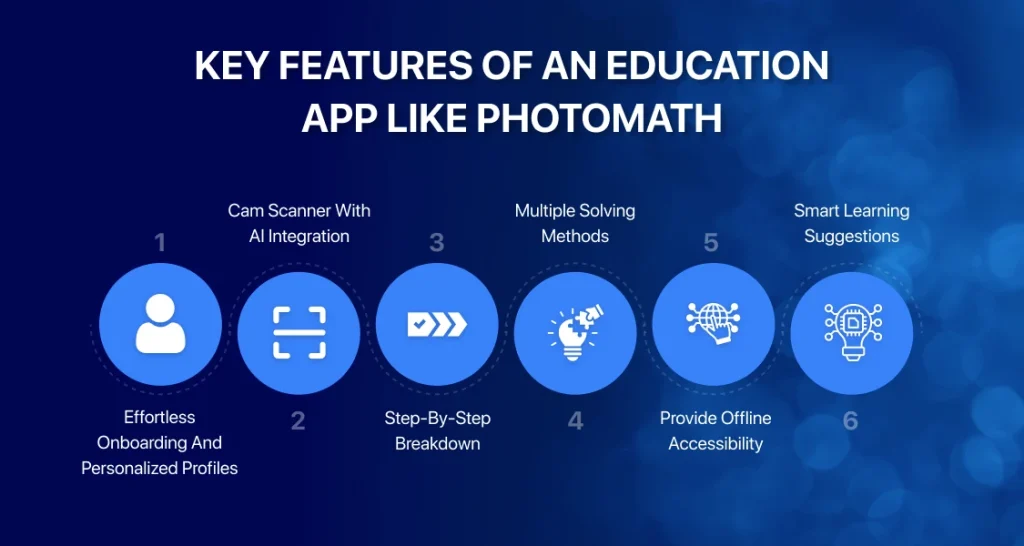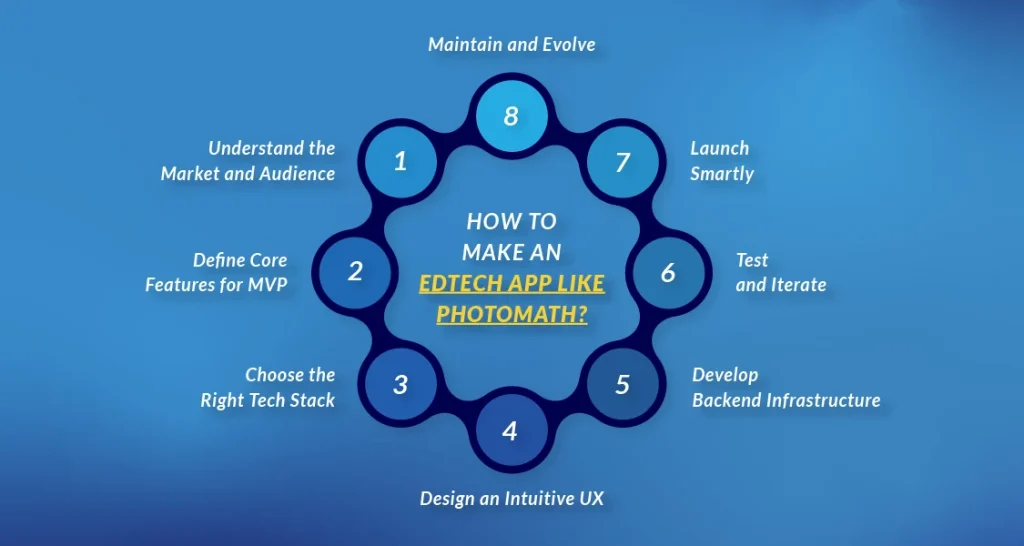Does this thought ever cross your mind how Photomath transformed from a basic math solver into one of the world’s most powerful AI-driven learning tools? In a world where we are addicted to instant solutions, step-by-step explanations, and the freedom to study as per the convenience. EdTech app like Photomath are becoming the pioneer technology in the education sector.
As per the latest reports, the EdTech market will touch the booming number of $231.08 billion by 2027, with a compound annual growth rate (CAGR) of 13.61% in the period of 2022-2027. As well as, the Global budget on EdTech is supposed to grow substantially, especially in AR/VR, from US$ 1.6 billion in 2018 to US$ 12.6 billion in 2025. (source)
If you’re interested in creating an app similar to Photomath, this comprehensive blog is for you. By the end of it you will understand the EdTech market, key features, tech architecture, development steps, and cost estimates. Let’s get started.
What is a Photomath App?
Photomath is a educational mobile app that allows users to solve math problems instantly via photo. Launched in 2014, and quickly became the most downloaded educational app internationally, with over 220 million downloads.
The app works on advanced AI and OCR technology to understand both handwritten and printed math equations. Once scanning is complete, you’ll get the answer and logic behind it to help users know how the solution is derived.
Whether you’re solving simple arithmetic or complex calculus. Photomath keeps it simple, and more understandable for students, parents, and teachers. It’s a perfect example of how an EdTech app like Photomath can boost learning and make education more interesting.
As demand for learning apps is on rise, more education app development company are endeavoring the potential of apps similar to Photomath to bring smart education tools for all.
How Does Photomath Work?
Photomath works by solving math problems through integrating your phone’s camera with AI technology to provide instant solutions. Here’s how the process works:
- Click a Photo: Open the app and focus your camera on the math problem, whether it’s typed or handwritten.
- Recognize the Equation: it works on Optical Character Recognition (OCR) to understand the content without any misses.
- AI Solving Engine: The app uses advanced AI-powered engines to scan and solve the equation.
- Step-by-Step Answer: It doesn’t just provide the solution but also simplifies into understandable steps.
This easy-to-use approach is the key reason why it got the tag of best learning app for adults and students alike. The app supports learning with solid reasoning, making it an important tool in both classrooms and homes.
If you’re thinking of building an EdTech website like Photomath, pay extra attention to intuitive UI/UX design and strong AI functionality. As the demand for apps like PhotoMath is growing, creating an experience that strikes a balance of simplicity and intelligence is key for standing out.
Key Features of an Education App Like Photomath

Creating an EdTech apps like Photomath is not limited to coding an app, it’s about creating a solution on which people can rely. Your users expect more than solutions; they want to feel guided, supported, and motivated. Below are the features that you might want to include in the app:
1. Effortless Onboarding and Personalized Profiles
Let users login into the app quickly with email, mobile number, or social logins. Let them create personal profiles so they can review previous problems, and trace back their learning trail over time. It’s a small step that makes the experience personalised.
2. Cam Scanner with AI Integration
Users take a picture of a math equation and your app instantly understands it through OCR. Then, smart algorithms kick in to provide the solutions. Accuracy makes the difference. Make it fast, simple, and responsive.
3. Step-by-Step Breakdown
A good solution highlights the “how,” not “what.” Let users have a full process with clear, easy-to-digest steps. Visual cues, interactive explanations, or even voice guidance can enhance this experience for different types of learners.
Read Also:- The Role of Artificial Intelligence in Education
4. Multiple Solving Methods
Some students learn better through the graphs over algebraic shortcuts. Provide 2-3 alternatives. Offering more than one solving path builds more preference and user favorability.
5. Provide Offline Accessibility
Don’t let the network stop learning. Give functionality to scan and generate answers even when they’re offline. Downloadable modules or cached tools would make it possible.
6. Smart Learning Suggestions
Through AI, figure out the strengths and weaknesses of users. Recommend Follow-up problems, short video explanations, or daily quizzes..
When you develop an app similar to Photomath, keep in mind, these features must have you can add more as per the requirement. They shape how the learner’s experience, think, and grow. Prioritize features that boost understanding and utility.
Read Also:- How To Develop an MVP: A Step-By-Step Guide
How to Make an EdTech App Like Photomath

Building your EdTech App Like Photomath can be tricky, but also rewarding. To create an app, you should work on a plan that covers technology, content, user experience, and monetization. There is a process mentioned below that will outshine your app from the other EdTech apps in the industry.
1. Understand the Market and Audience
Before getting into the development process, do the thorough market research to know your target audience and their wants. Your user base could be of K-12 students, college learners, or exam prep candidates. Then, research what they expect from a math learning software and try to keep those features in the app.
2. Define Core Features for MVP
- Before developing, narrow down what you need to include in Minimum Viable Product (MVP). These could include:
- Camera-based problem recognition
- Instant AI-powered solutions
- Detailed explanations
- Multi-language support
- Review and tracking
- Offline access
3. Choose the Right Tech Stack
Use a combination of OCR (Optical Character Recognition) and AI/ML frameworks to power your app. For OCR, tools like Mathpix or Google ML Kit are the best fit. For the AI integration, you can try TensorFlow or build custom models.
4. Design an Intuitive UX
Great design makes identity. Keep UI simple, good for students, and optimized for experts and beginners. Must include clear buttons, tooltips, and smart navigation. Consider feedback from early users and iterate accordingly.
Read Also:- 12 Best Online Education Apps Like Coursera for 2025
5. Develop Backend Infrastructure
Set up a robust backend to process user data, content, performance analytics, and security. Select scalable cloud platforms like AWS or Firebase. Keep data privacy through secure login, encrypted databases, and GDPR compliance.
6.Test and Iterate
Prior to launch, test across devices, operating systems, and user scenarios. Conduct both automated and manual testing to get accuracy, speed, and UI responsiveness. Take feedback and refine accordingly.
7. Launch Smartly
Plan your launch in stages beta test with a batch. Market on limited-time features, referral discounts, or bonus content for promotion. Target schools, online communities, and influencers in the EdTech space.
8. Maintain and Evolve
Post-launch is where processes demand extra attention. Scale the app’s features based on user feedback like textbook libraries, animated guides, or even real-time tutoring. Consistent updates signal reliability and boost user retention.
When you work with an experienced educational app developer or a reliable e learning mobile app development company, you gain insights and technical support that sets the path of app’s success.
How Much Does It Cost to Create an EdTech App Like Photomath?
The cost of building an app similar to Photomath depends on complexity, location, and the development team. Here’s a rough breakdown:
| Development Phase | Estimated Cost Range (USD) | Description |
| Market Research & Strategy | $3,000 – $8,000 | Tap on the user needs, do competitor analysis, and map out core functionalities. |
| UI/UX Design | $4,000 – $10,000 | Develop intuitive and engaging UI for mobile and web platforms. |
| Frontend Development | $10,000 – $25,000 | App version for iOS, Android, or both. |
| Backend Development | $12,000 – $30,000 | Integration of server-side logic, API, and secure database management. |
| AI/ML Integration For OCR + Solver | $15,000 – $40,000 | Development of the AI engine for equation recognition. |
| Testing | $5,000 – $10,000 | Functional testing on cross platforms. |
| Deployment & App Store Launch | $2,000 – $5,000 | Launch setup, and App store optimization |
| Ongoing Maintenance & Updates | $2,000 – $8,000/month | Frequent feature updates, bug fixes, and system maintenance. |
Total Estimated Cost: $50,000 – $130,000+ varying on complexity, team expertise, and desired features.
Conclusion
After understanding the pricing, features, and development procedure, you can make informed decisions about math problem-solving apps. With a focus on the requirements, you can use the best technology to get improved calculation and image processing outcomes. Evaluate your journey and create an app like PhotoMath today!
FAQs
Feature / App Photomath Microsoft Math Solver Microsoft Mathematics Mathly Socratic Mathway
Camera-Based Scanning Yes Yes No Yes Yes Yes
Step-by-Step Explanations Yes Yes Yes Yes Yes Yes
Multiple Solving Methods Yes Yes No No No Yes
Offline Mode Yes Yes No No No Yes
Supports Graphing Yes Yes Yes No No Yes
Voice Input No Yes No No Yes Yes
Animated Explanations Yes No No No Yes No
Multilingual Support Yes Yes No No Yes Yes
Premium Features Yes No No Yes No Yes
Platform Availability iOS, Android iOS, Android, Web Windows iOS iOS, Android iOS, Android, Web
Ans. This can vary because of different factors involved, building an MVP can be around 4 to 6 months but this can change based on the complexity, features etc.
Ans. You can use OCR (OpenCV, Microblink), AI/ML models, cloud storage, and mobile frameworks like Flutter or React Native as they are popular ones. However, take expert advice from your tech partner.
Ans. Yes. Popular models you can employ are freemium access, in-app purchases, and subscriptions for advanced features or premium content.











